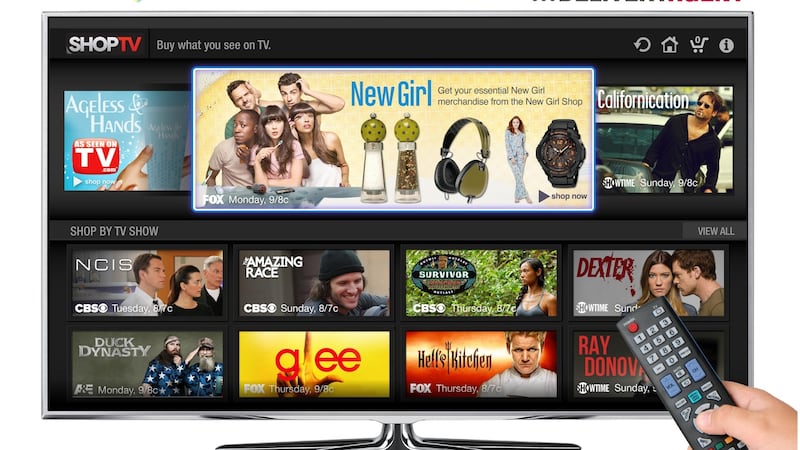T-commerce could be the new e-commerce. What is T-commerce, you ask? Well, it’s trading via a smart TV or tablet. That’s not to say e-commerce is dead; it is changing, though, by moving away from advertising and towards “shoppable” content.
H&M first put T-commerce in the spotlight when it ran a real-time shoppable ad during the Super Bowl in the US.
Viewers with compatible TVs such as the internet-connected Samsung smart TV could buy the clothing featured in the ad directly from their TV remotes. Using them, they could access the product and purchasing information in real time.

T-commerce and shoppable content will revolutionise the e-commerce industry, according to Niall O’Gorman, co- founder of ChannelSight and global director of e-commerce strategy and innovation at Mondel?z.
“In the future, you will be able to get items you like off a TV show. You could press the red button on your remote to bring up items from the show to buy. You might like the outfit the actor is wearing and want to buy that.”
He says many videos online, on sites such as YouTube, already offer the option for people to buy.
“If you watch a pre-roll video [a promotional video message/ad that plays before an online video], there are buy buttons within them now. You can watch a video about a brand and a buy button will be at the bottom. It can’t be intrusive.”
“Try buttons are equally as important as buy buttons, thus there’s also now buttons you can click to try a sample of the product.”
Banner ads
He says advertising, especially banner ads, previously drove e-commerce, but that this is at saturation point now, with more and more people using ad blocking.
“People are sick of all these ads. They’re considered spam and they’re intrusive. There’s a move towards generating great engaging content such as shoppable recipes. That will drive e-commerce in the future. People are tired of ads and need to cut through the clutter.”
O’Gorman says shoppable content and shoppable ads are the latest manifestation of how the retail experience is being transformed by technology. Internet users can click on an ad for a product and buy that product immediately.
“You’ll get a longer-lasting engagement with the user if you create great content rather than an advert.
“When people see recipes online they like, they then have to go to the supermarket and find all the items in the recipe. But what if you could make all the ingredients shoppable? You could click on the ones you want and they would go straight to a basket for purchase.”
O’Gorman’s company ChannelSight allows brands to add “buy now” buttons to product pages, social media video advertising and other online campaigns, linking to retailers that stock the products.
Operating in 37 countries globally, it works with brands such as Cadbury, Oreo, Philips and Veet and has posted seven-figure annual revenues since its foundation.
Clients
The company, founded in 2013, recently raised €3.3 million in funding and quickly secured Philips as its first client.
“I met Philips in Amsterdam and said: ‘I have no company, no developers, no employees and no product, but I believe I can make a world-class solution for you.’ There was laughter all round. They gave us a chance.”
Mondelez has also collaborated with ChannelSight to use its e-commerce technology to drive sales, although O’Gorman is quick to point out he had nothing to do with the decision, despite his involvement with both companies.
“When ChannelSight was starting out we had no money, so we had to keep working . . . it’s tough to balance between the two, but the benefits outweigh the challenges.”
ChannelSight embedded "buy now" buttons were embedded across Mondelez International's online media, on Facebook, Twitter and YouTube, throughout 25 global markets globally.
Brands
For now, 90 per cent of all grocery sales are made in stores. Mondelez, which makes brands such as Cadbury and Oreo, wants to accelerate online transactions of its products.
"A few years ago you would never have thought of buying a packet of cookies online. Today lots of people purchase online at stores like Tesco and Carrefour."
O’Gorman says brands are maturing and understanding that they have to sell other brands as well as their own
“People will buy 25 or 50 items in Tesco online to get home delivery. They won’t do it for one item. Thus brands will encourage people to make a recipe or suggest what products go well with other products.
“To help sell your product, you need to help sell other products. You also provide value to the retailer, as you’re helping to build baskets.”
He says consumers hate paying for shipping or delivery and feel like they need to buy more to make it worthwhile.
“Retailers are seeing this. They are offering free or subsidised delivery, or click and collect options.”
As for the future, O'Gorman says every device is becoming more aware, such as Amazon Dash, which sits in your house and allows you to order things. "You will be able to have things automatically reordered when your pantry runs low."












